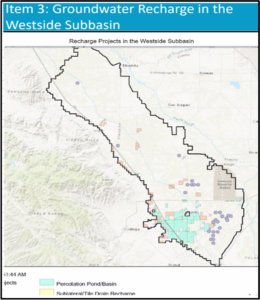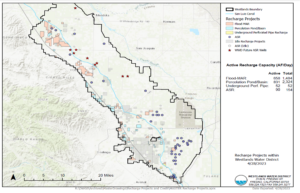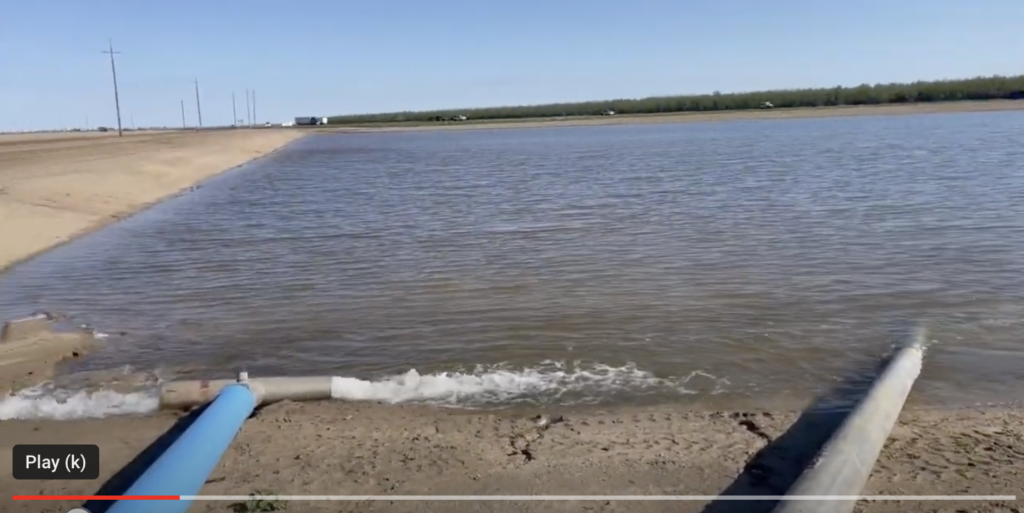Groundwater recharge – or the lack of it – was a driving force behind the sweep of new board members who took over the behemoth Westlands Water District last fall.
“Urgently develop groundwater recharge,” was the top plank in the platform of four candidates who won election in November.
And the district has, indeed, built a 30,000-acre network of grower-owned recharge ponds with enough capacity to recharge, or absorb, 3,300 acre feet a day into the overtapped aquifer.
So, it was surprising that the district showed it was only recharging a total of about 572 acre feet per day through April 30, according to a report at Westlands’ May 16 board meeting. A map presented at the meeting shows only a small fraction of recharge ponds in use.
Staff also reported that Westlands had only captured 6,508 acre feet of flood water from the Sacramento-San Joaquin Delta, known as “215 water.”


At 3,300 acre feet per day, however, the ponds could have taken at least 82,500 acre feet of flood water, or more, through April.
The district does expect to continue taking flood water into the fall. But the water missed so far has long since been lost to the ocean.
In 2017, the last year Westlands received 100% of its water allocation, 263,619 acre feet of 215 water was similarly lost, according to district records and past interviews.
New board members vowed to change that. Yet, it appears Westlands is still only taking a trickle even in this year of extraordinary bounty.
Lost opportunity?
Westlands Board President Jeff Fortune agreed the district had missed recharge opportunities in the past but said he’s proud of the progress the district has made.
“I think we’re doing a fantastic job,” he said. “We’ve gone from 0 to 100 miles per hour awfully fast. You could say we should have been more prepared but no one saw this weather pattern coming.”
When everyone realized how much water could be available, he said the district made sure it could sock away up to 100,000 acre feet.
“Now, I think we will surpass that,” he said.
Westlands Deputy General Manager Russ Freeman said he expects the district to take in 130,000 acre feet of 215 flood water this year.
It’s hard to say if the district lost an opportunity to take more, he said, because so many outside factors can affect how much water is pumped from the delta including power outages, environmental regulations and whether Westlands growers decided to use their ponds for crops.
“Without reviewing the day-to-day operations of the pumps, I couldn’t say,” if Westlands had lost water, Freeman said.
Junior rights
Westlands receives water from the federal Central Valley Project overseen by the Bureau of Reclamation.
Water is pumped out of the south end of the delta near the town of Tracy and into the San Luis Reservoir. Then it is moved through the Delta-Mendota Canal to various contractors, including Westlands, which has a contract for 1.15 million acre feet, by far the largest among the so-called South of Delta contractors.
When San Luis Reservoir fills, as it did on April 5, the Bureau of Reclamation allows contractors to take water directly from the pumps at Tracy.
That excess flood water is known as 215 water.
While it has a large contract, Westlands is considered a junior water rights holder, with no riparian rights and having formed later than other agricultural water districts. So, in times of drought, its deliveries are cut first. In 2021 and 2022, it received a 0% allocation.
That, and the advent of the state’s Sustainable Groundwater Management Act, made groundwater recharge imperative for many growers.
Minuscule numbers
Though Westlands is taking more flood water for recharge than it has in the past, the amount recharged so far this year is minuscule when compared to how much recharge other, much smaller, districts have been able to achieve.
Tulare Irrigation District, which covers 70,000 acres, has recharged 145,000 acre feet so far, according to General Manager Aaron Fukuda. And Rosedale-Rio Bravo Water Storage District in Kern County, a 44,000-acre district, has socked away 123,000 acre feet of flood water, according to General Manager Dan Bartel.
Unlike those and other ag water districts, Westlands doesn’t have its own recharge facilities. And though the district is vast, covering 600,000 acres, much of its land has drainage problems or is underlined with an impermeable clay layer.
Instead, it has partnered with its growers to build recharge ponds on their lands. Over the course of about two years, the district and growers established about 30,000 acres of ponds with a combined capacity to sink 3,300 acre feet per day.
But the district hadn’t established policies laying out the operating rules governing those partnerships before the March storms made it clear there would be recharge opportunities this year.
Recharge policies
A series of sometimes conflicting notices were issued from the board starting January 11. At first, the district announced growers would need approval to take flood water for recharge.
On March 8 the board stated growers with approval would also have to pay $200 an acre foot for flood water.
On March 17, a new notice told growers they would no longer need prior approval to take flood water and it would only cost $170 an acre foot.
Then on March 29, Westlands announced two new programs: It would pay growers $100 per acre foot to recharge flood water and the district would retain the groundwater credits; or it would pay the grower nothing and the district and grower would split the groundwater credits 50/50.
On April 13, the district announced all growers who contracted for surface water would get a share of flood water.
Consequently, only a handful of growers had signed up to recharge water and only an average 572 acre feet a day was being percolated into the aquifer instead of 3,300 acre feet, according to district reports.
Board President Fortune was not dissuaded by the numbers.
“Sure, we can always do better,” he said. “But we’ve never done this before.”
Share this:
- Click to share on Facebook (Opens in new window)
- Click to share on Twitter (Opens in new window)
- Click to share on LinkedIn (Opens in new window)
- Click to share on Reddit (Opens in new window)
- Click to share on Tumblr (Opens in new window)
- Click to share on Pinterest (Opens in new window)
- Click to share on Pocket (Opens in new window)
- Click to share on Telegram (Opens in new window)
- Click to share on WhatsApp (Opens in new window)
- Click to print (Opens in new window)








You must be logged in to post a comment.